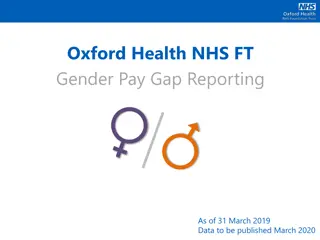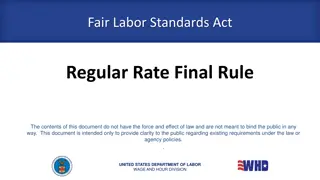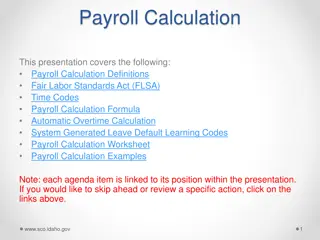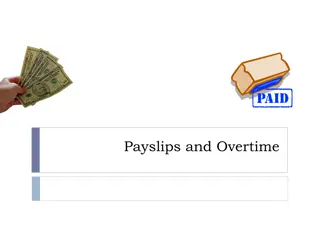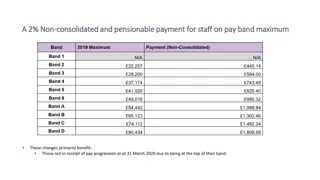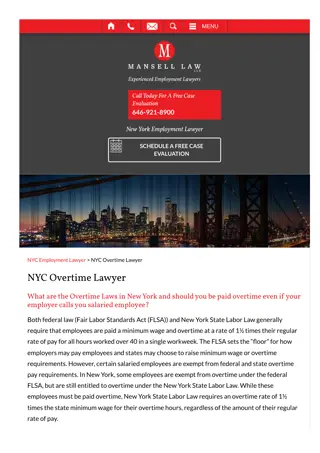Overtime Pay on Government Contracts
This content explains how overtime pay is handled on government contracts through laws like the Contract Work Hours and Safety Standards Act (CWHSSA) and the Fair Labor Standards Act (FLSA). It covers the requirements, coverage, and application of CWHSSA, highlighting the need for overtime pay for specific contract workers.
Download Presentation

Please find below an Image/Link to download the presentation.
The content on the website is provided AS IS for your information and personal use only. It may not be sold, licensed, or shared on other websites without obtaining consent from the author.If you encounter any issues during the download, it is possible that the publisher has removed the file from their server.
You are allowed to download the files provided on this website for personal or commercial use, subject to the condition that they are used lawfully. All files are the property of their respective owners.
The content on the website is provided AS IS for your information and personal use only. It may not be sold, licensed, or shared on other websites without obtaining consent from the author.
E N D
Presentation Transcript
Overtime Pay on Government Contracts
Overtime Pay Neither DBA nor SCA provide premium rates for overtime hours of work, but both recognize other Federal laws that do: Contract Work Hours and Safety Standards Act (CWHSSA) (40 U.S.C. 327-332) applies to contracts in excess of $100,000 ($150,000 for contracts procured under the Federal Acquisition Regulations) that employ laborers, mechanics, guards, and watchmen. Fair Labor Standards Act (FLSA) (29 U.S.C. 201, et seq.)applies more broadly, with over 143 million workers subject to coverage.
Purpose of CWHSSA (40 U.S.C. 3701 et seq.) Enacted in 1962 - consolidated a number of eight hour laws that provided for overtime pay on federally financed contracts employing laborers and mechanics In 1986, the federal daily overtime requirement was repealed to require overtime pay only after 40 hours a week Both CWHSSA and FLSA now require overtime pay for work over 40 hours in a workweek
Requirements of CWHSSA Requires overtime pay for laborers, mechanics, guards, and watchmen at a rate of one and a half times the basic rate of pay for hours worked in excess of 40 in a workweek on covered contracts. Liquidated damages can be assessed per day for each laborer, mechanic, guard, or watchman not paid proper overtime
Coverage of CWHSSA Covers contracts over $100,000 ($150,000 for contracts procured under the Federal Acquisition Regulations) that require or involve the employment of laborers, mechanics, watchmen or guards on DBA covered construction contracts DBRA covered construction contracts; and SCA covered service contracts Is self-executing (even if not stated in contract) Has no site of the work limitation
Application of CWHSSA CWHSSA applies to laborers, mechanics, guards and watchmen for the time spent on covered contract work only. When determining whether an employee has worked overtime hours under CWHSSA Total up all the time each employee spent working on covered contracts (off-site as well as on-site on DBA/DBRA projects); Exclude all commercial, non-government, non-covered work.
Application of CWHSSA CWHSSA requires the payment of time and one-half the basic rate of pay for all hours worked in excess of 40 hours in a week. The basic rate of pay under CWHSSA is the straight time hourly rate, which will generally be the amount listed under the column Rates on the applicable wage determination. The basic rate cannot be less than the basic hourly rate required in an applicable wage determination, not including any required fringe benefit amount. See 29 C.F.R. 5.24. However, if an employee is paid a regular rate above the basic hourly rate (excluding fringe benefits or cash payments in lieu of fringe benefits), that regular rate will be considered the basic rate.
Application of CWHSSA Amounts paid to fulfill the fringe benefit portion of the prevailing wages listed in the applicable wage determination are excluded in computing overtime obligations under CWHSSA. This exclusion applies to both cash payments made to comply with the fringe benefit portion of the prevailing wage requirement and contractor contributions to bona fide benefit plans made to comply with that requirement.
Application of FLSA Overtime Pay On contracts to which CWHSSA does not apply (for example, on DBRA a prime contract of $100,000 or less, or a FAR contract of $150,000 or less) overtime pay requirements may apply to a contractor or subcontractor under the FLSA. On contracts to which CWHSSA applies, FLSA may also apply.
Application of FLSA Overtime Pay As a general standard, Section 7(a) of the FLSA, as amended, provides that an employer shall not employ any employee to work in excess of 40 hours in a workweek unless such employee receives compensation for his or her employment in excess of 40 hours at a rate not less than one and one-half times the regular rate awhich he or she is employed. 29 U.S.C. 207(a); see also 29 C.F.R. 778.101.
Application of FLSA Overtime Pay Unless specifically exempted from FLSA overtime pay requirements, an employee who performs work on both federally funded/federally assisted projects and commercial work in the same workweek must receive an overtime premium for hours worked in excess of 40 in the workweek. 29 C.F.R. 778. (Note: 29 C.F.R. 5.32 and 778.6 discuss dual application of Davis-Bacon and FLSA overtime requirements.)
Overtime Pay is for Hours Worked CWHSSA and FLSA requirements apply only to hours worked. Non-work hours such as paid holidays and paid leave are not counted in computing overtime pay. Rules concerning Hours Worked are at 29 C.F.R. Part 785.
Work in More than One Classification If in a single workweek an employee works in more than one classification for which different non- overtime rates of pay have been established, the overtime pay should be computed based on the weekly average rate (or regular rate ): the total straight time pay for work (at all such rates) during the week, divided by the total number of hours worked at all jobs worked in the workweek. See 29 C.F.R. 778.115.
Work in More than One Classification An employee who performs work in two or more classifications for which different straight time hourly rates are established may also agree with his/her employer in advance of performing the work to be paid during overtime hours at a rate not less than one and one-half times the hourly non- overtime rate established for the type of work he/she will perform during such overtime hours. See 29 C.F.R. 778.115 and 778.415-778.419.
Work in More than One Classification: Examples An employee is hired to perform work on a covered construction contract in two job classifications: painter and electrician. The wage determination rate for an electrician is $12.00 (basic hourly rate) plus $2.50 in fringe benefits. The wage determination rate for a painter is $10.00 (basic hourly rate) plus $3.00 in fringe benefits. The payroll shows that the worker performed 30 hours of painting and 18 hours of electrical duties The next two slides illustrate the two methods of computing the overtime pay.
Work in More than One Classification: Examples Method 1: Computation of the overtime premium based on the weekly average regular rate for the work week. Step 1: Determine the straight time wages due excluding fringe benefits: 30 hours at the painter s rate of $10.00 = $300.00 18 hours at the electrician s rate of $12.00 = 216.00 Total straight time wages = $516.00 (continues onto next slide)
Work in More than One Classification: Examples Step 2: Calculate the regular rate : ($516.00 / 48 hours worked) = $10.75 regular rate Step 3: Compute the overtime premium due: ($10.75) x 8 overtime hours worked = $43.00 Note: If a worker s regular rate of pay exceeds the basic hourly rate listed in the applicable wage determination, then the employee s regular rate of pay must be used in computing the overtime pay premium for FLSA purposes. See 29 C.F.R. 778.107-778.109.
Work in More than One Classification: Examples Method 2: Computation of the overtime premium based on the rate in effect when the overtime hours were worked (if by established advance agreement, as described previously). In this example the eight overtime hours occurred on a Saturday. The overtime premium could be computed as follows: ($12.00) x 8 = $48 Note: In some cases, a question arises over whether a cash payment made to a laborer or mechanic is paid in lieu of a fringe benefit contribution or whether it is simply part of the individual s normal basic hourly rate. In the latter situation, the cash payment is not excludable in computing the overtime pay obligation.
Overtime Pay Computations on DBA/DBRA contracts The next three slides provide examples that reflect correct computations under CWHSSA or FLSA for an employee who worked 44 hours on a covered DBA/DBRA contract as an electrician, where the wage determination rate for an electrician is $22.00 (basic hourly rate) plus $5.00 in fringe benefits. The slides relate to different ways contractors may meet the DBA/DBRA and CWHSSA/FLSA requirements for hours worked over forty.
Overtime Pay Computations DBA/DBRA Example 1 If the employer paid $22.00 in cash wages and paid $5.00 in fringe benefits, the electrician would receive: 44 hours x $22.00 = $ 968.00 for cash wages 44 hours x $ 5.00 = $ 220.00 in fringe benefits 4 hours x x $22.00 = $ 44.00 for CWHSSA earnings $1232.00
Overtime Pay Computations DBA/DBRA Example 2 If the employer paid $20.00 in cash wages and $7.00 in fringe benefits: 44 hours x $20.00 = $ 880.00 for cash wages 44 hours x $ 7.00 = $ 308.00 in fringe benefits 4 hours x x $22.00 = $ 44.00 in CWHSSA earnings $1232.00
Overtime Pay Computations DBA/DBRA Example 3 If the employer paid $24.00 in cash wages and $3.00 in fringe benefits: 44 hours x $22.00 = $ 968.00 for cash wages 44 hours x $ 2.00 = $ 88.00 cash in lieu of fringes 44 hours x $ 3.00 = $ 132.00 in fringe benefits 4 hours x x $22.00 = $ 44.00 in CWHSSA earnings $ 1232.00
Overtime Computations SCA Contracts The next two slides provide examples that reflect correct computations under CWHSSA or FLSA for an employee who worked 44 hours on a covered SCA contract as a janitor, with a wage rate of $15 per hour and a $4.41 H&W The examples show how those computations would be different depending on whether the wage determination requires fixed cost or average cost fringe benefits
Overtime Compliance with Fixed Cost H&W Benefits An employee worked 44 hours on a covered contract as a janitor at a WD rate of $15 plus $4.41 in fixed cost H&W FBs per hour. 40 hours X $4.41 44 hours X $15.00 4 hours X $15.00 x 1/2 = $ 30.00 O/T Pay__ Total = $176.40 H&W FBs = $660.00 S/T Wages $866.40
Overtime Compliance with Average Cost H&W Benefits An employee worked 44 hours on a covered contract as a janitor at a WD rate of $15 plus $4.41 in average cost H&W FBs per hour. 44 hours X $ 4.41 44 hours X $15.00 4 hours X $15.00 x Total = $194.04 H&W FBs = 660.00 Wages = 30.00 Overtime Pay = $884.04
Liquidated Damages CWHSSA The statute provides that liquidated damages shall be computed in the sum of $26 per calendar day on which an individual did not receive the required overtime compensation Liquidated damages are assessed by the contracting agency, but the contracting agency must seek the concurrence of the Administrator to reduce or waive them, per 29 CFR 5.8 FLSA The statute provides that liquidated damages shall be assessed in an amount equal to the unpaid overtime compensation Liquidated damages are assessed by WHD
Computing Liquidated Damages under CWHSSA Are computed at $26 per day per violation: S M T W T F S Total Regular Time 0 10 12 13 9 8 3 55 15 weekly hours of overtime were worked on 3 calendar days (Thursday, Friday, Saturday) without payment of overtime. Liquidated damages computed at $78.
Disclaimer This presentation is intended as general information only and does not carry the force of legal opinion. The Department of Labor is providing this information as a public service. This information and related materials are presented to give the public access to information on Department of Labor programs. You should be aware that, while we try to keep the information timely and accurate, there will often be a delay between official publications of the materials and the modification of these pages. Therefore, we make no express or implied guarantees. The Federal Register and the Code of Federal Regulations remain the official source for regulatory information published by the Department of Labor. We will make every effort to keep this information current and to correct errors brought to our attention.




